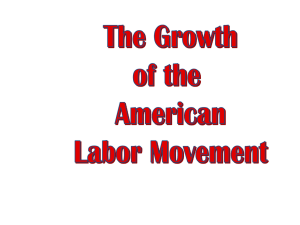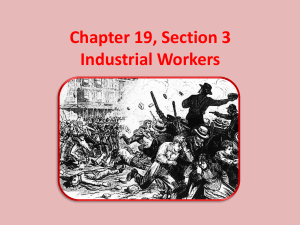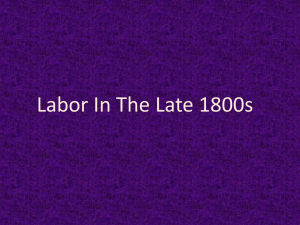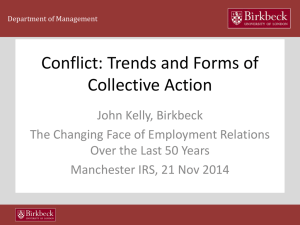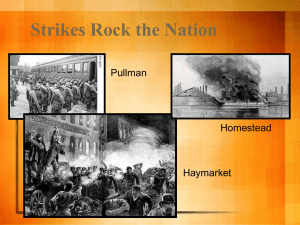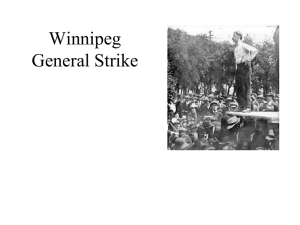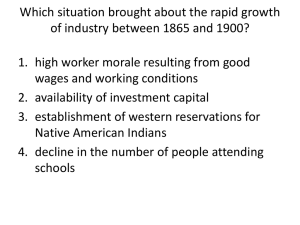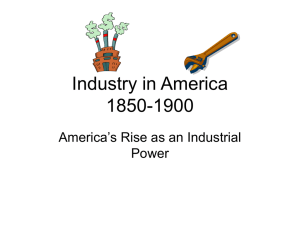Lecture Notes--Unions,Strikes
advertisement
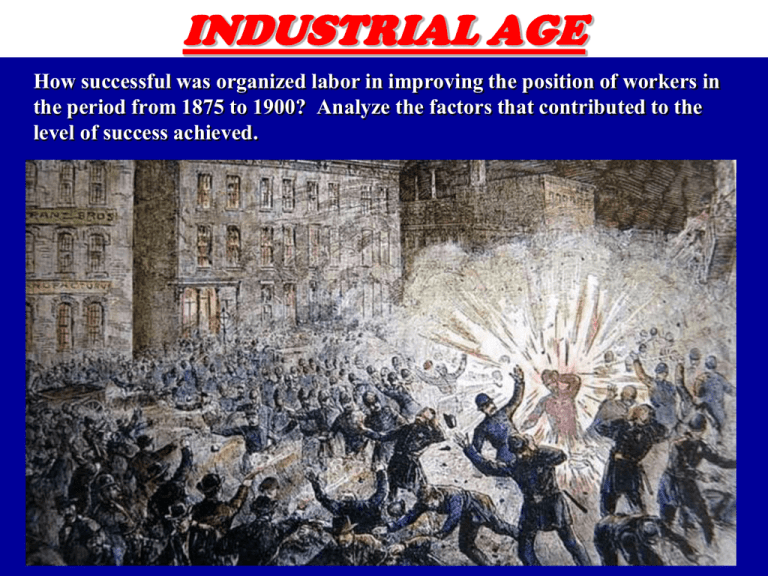
INDUSTRIAL AGE How successful was organized labor in improving the position of workers in the period from 1875 to 1900? Analyze the factors that contributed to the level of success achieved. INDUSTRIAL AGE • VI. Union Movement A. Knights of Labor 1. Leader Uriah Stephens & Terence Powderly 2. Members/Eligibility Open Membership = Male, Female, African American, etc. 3. Goals Reform Economic system = worker cooperatives, abolition of trusts, abolition of child labor, 8hr. Day, govt. regulation 4. Methods of Achieving Goals Arbitration (preferred, but couldn’t stop local assemblies from striking 5. Results/Public Perceptions a. 1886 = May Day & Great Upheaval = strike failures and fear of economic chaos b. Haymarket = become associated with anarchists c. Large and loosely organized d. By 1890s = down to 100,000 and disappear by mid 1890s INDUSTRIAL AGE • VI. Union Movement B. American Federation of Labor (AFL) 1. Leader Samuel Gompers 2. Members/Eligibility Skilled Workers = Association of Craft Unions 3. Goals “bread & butter” issues (accept capitalism/wage system) Better Wages, Hours, Working Conditions = not economic or governmental reform; concentrate on relationship between management and labor 4. Methods of Achieving Goals bargain collectively & closed shop walk out, boycott, strikes against employers who refuse to bargain 5. Public Perceptions Not as bad as K of L, but still associated with anarchists after Haymarket INDUSTRIAL AGE a. Causes i. Wages Cut 10% for 2nd time since 1873 • VI. Union Movement – C. Strikes • 1. Railroad Strike 1877 INDUSTRIAL AGE • VI. Union Movement – C. Strikes • 1. Railroad Strike 1877 b. Labor Actions i. Strike = First National Strike, 11 states, 2/3 of country’s rails ii. Railroad strikers joined by 500,000 workers from other industries iii. Disrupt service from Baltimore to St. Louis, destroy equipment, riots in Pittsburgh & other cities INDUSTRIAL AGE • VI. Union Movement – C. Strikes • 1. Railroad Strike 1877 c. Response & Results i. President Hayes uses Federal Troops in W.V., militiamen used in other cities, 100 killed by end ii. Shows resentment on both sides, and lengths both sides would go to; Government use Federal Troops iii. Fear of union by propertied classes INDUSTRIAL AGE a. Causes i. May Day labor movement in Chicago ii. Strike and violence at McCormick Harvester plant • VI. Union Movement – C. Strikes • 2. Haymarket Riot, 1886 INDUSTRIAL AGE • VI. Union Movement – C. Strikes • 2. Haymarket Riot, 1886 b. Labor Actions i. Labor leaders call for public meeting at Haymarket Square ii. Radical and anarchists present INDUSTRIAL AGE • VI. Union Movement – C. Strikes • 2. Haymarket Riot, 1886 c. Response & Results i. Police attempt to break up, bomb thrown ii. Kills 7 policemen, 60+ injured; police fire into crowd and kill 4 civilians iii. 8 anarchists accused & found guilty; 7 sentenced to death, 4 executed, 1 suicide, 3 pardoned (Gov. John Altgeld) iv. Most middle class associate unions w/ anarchists INDUSTRIAL AGE a. Causes i. Frick & Carnegie cut wages 20% in 1892 ii. Had been cutting wages for two years = not want to pay workers by ton produced but by sliding scale (market price) = want streamline efforts & cut labor costs iii. want to get rid of union at Homestead plant • VI. Union Movement – C. Strikes • 3. Homestead Strike, 1892 INDUSTRIAL AGE b. Labor Actions i. Strike • VI. Union Movement – C. Strikes • 3. Homestead Strike, 1892 INDUSTRIAL AGE • VI. Union Movement – C. Strikes • 3. Homestead Strike, 1892 c. Response & Results i. Frick closes Plant & calls in Pinkertons (strikebreakers) = violence erupts, 13 killed & 100+ wounded INDUSTRIAL AGE • VI. Union Movement – C. Strikes • 3. Homestead Strike, 1892 c. Response & Results Firing continued for hours, “One observer estimated more than one thousand shots were fired in the first ten minutes” “The noise that they made on shore was awful, and it made us shake in our boots. We were penned in like rats….All of our men were under the beds and bunks, crying and trembling.” (Gillon, Ten Days…) INDUSTRIAL AGE • VI. Union Movement – C. Strikes • 3. Homestead Strike, 1892 c. Response & Results “According to one account, the joyous crowd formed itself ‘into two lines, 600 yards long, between which the men from the barges had to pass.’ The crowd assaulted the detectives as they walked the gauntlet. A woman used her umbrella to punch out the eye of one man. ‘The men screamed for mercy. We were clubbed at every step.”(Gillon, Ten Days…) INDUSTRIAL AGE • c. Response & Results ii. Governor sends in state militia iii. Scabs used to resume production iv. public opinion turns when radical attempts assassinate Frick v. Union surrenders after 4 months & is broken VI. Union Movement – C. Strikes • 3. Homestead Strike, 1892 INDUSTRIAL AGE • VI. Union Movement – C. Strikes • 4. Pullman Strike, 1894 a. Causes i. Pullman cut wages 25% ii. Refused to reduce rents in Pullman town (already higher than surrounding rents) INDUSTRIAL AGE b. Labor Actions • i. Workers Strike & helped by American Railway Union led by Eugene Debs ii. Effects rail transportation across the country VI. Union Movement – C. Strikes • 4. Pullman Strike, 1894 INDUSTRIAL AGE c. Response & Results • i. Gov. Altgeld refuses to call out militia; Pres. Cleveland & Att. Gen. Olney get court injunction = interfering w/ mail ii. Debs & union leaders refuse, arrested and jailed; strike broken iii. Use of court injunction gives employers powerful weapon against unions VI. Union Movement – C. Strikes • 4. Pullman Strike, 1894
